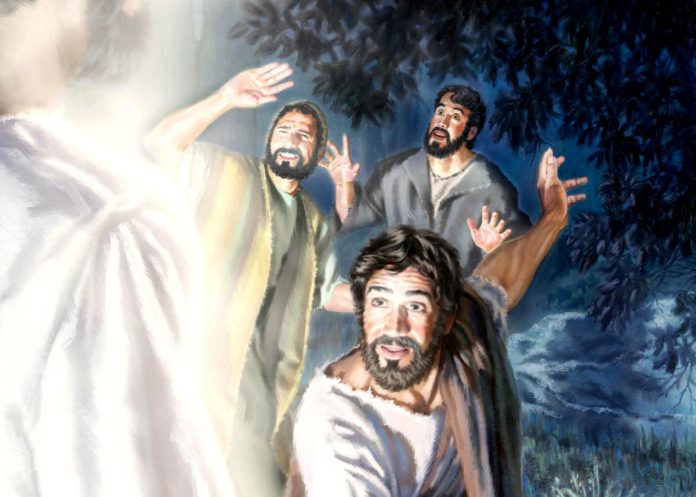Sa pagbabagong-anyo ni Jesus sa bundok ng Tabor, ang ebanghelyo ay tungkol sa maningning na kasuotan nina Jesus, Moises at Elias. Medyo na star-truck si Pedro. Hindi niya malaman kung anong gagawin. “Gumawa tayo ng tatlong kubol!” sabi niya.
Ano daw? Sa totoo lang hindi niya alam ang kanyang pinagsasabi. At may nagsalita mula sa langit: “Ito ang aking Anak. Pakinggan ninyo siya.” ‘Yan ang ending ng Transfiguration narrative.
Pero kung ipagpapatuloy natin ang pagbabasa ng ebanghelyo ni Mateo, iba ang makikita mo pagbaba nila ng bundok sa sunod na araw. Magulo. May batang inaalihan ng demonyo. Sumusigaw. Parang epileptic. Palagi daw nahuhulog sa apoy o tubig. Hindi nila maintindihan kung bakit. At hindi kayang pagalingin ng mga alagad ni Hesus.
Pagkatapos, sinabi ni Hesus, ang malungkot na mensaheng matagal maintindihan ng mga alagad: na ipagkanulo siya, papatayin, at mabuhay na mag-uli. Dito sinabi ng biblia: “at nalungkot sila ng sobra.”
Nalungkot sila dahil gusto nilang laging manatili sa toktok ng bundok.
But the real transfiguration is on the rough ground. The real challenge is not on the mountain top but on the valley, on the plain – where people shout in pain, where victims suffer and cry, where people are hungry and the government neglects them, where they begged for their lives but still die.
The Transfiguration of Jesus is a transformative experience of light in the midst of darkness, of healing in the midst of pain, of glory in the midst of seeming defeat, and of life in the midst of palpable death. It is a promise, a hope. There are many victims, yes! But ironically, they are also our witnesses of the resurrection.
Pero hindi nakikita ang katotohanang ito ng maraming tao. May dalawang klaseng tao akong nakita sa gilid ng bundok ng Tabor.
Una, maraming tao ang nag-aagawan ng posisyon sa kanan at kaliwa ni Jesus. Maraming tao ang abala sa kanilang pangungurakot at pagsasamantala. Sumisipsip. Nagpapalakas. Pilit na binabaligtad ang kasaysayan makasipsip lang. Lahat sila sumisigaw ng “Bagong Pilipinas”! At tulad ng mga alagad, lahat sila ay nais na maging makapangyarihan, nag-aagawan ng upuan sa kanan at kaliwa ng kanilang sinisipsipan.
Ikalawa, sa kabilang banda, maraming tao ang gustong manahimik na lamang sa tuktok ng bundok. Nais nilang magtayo ng tatlong kubol at doon manirahan. Ayaw nilang makialam sa panaghoy ng mga mahihirap at namatayan. Siguro takot sila o di kaya’y ayaw magambala.
O, di kaya, na-discourage sila. Dahil minsan sila’y lumaban ngunit natalo o di kaya nadaya. Kaya ayaw na nila. Back to normal na raw. Tanggapin na lang natin. Ganito talaga ang Pilipinas. Sa tingin nila ang kabanalan ay personal o sa loob lang ng simbahan. Kahit patuloy pa rin ang pangungurakot at dayaan. Kahit patuloy pa rin ang dating kalakaran. Kahit patuloy pa rin ang paglalapastangan ng kapaligiran.
Siguro, tama nga sila. Hindi naman talaga dapat makisawsaw ang simbahan sa usaping panlipunan.
But the Lord told Peter, James, and John to go down the mountain, to go where people are shouting in pain. It is in the valley that we are called to live our Christian lives, amidst the disturbing anguish of our people. Not in the holy silence of the mountain nor in the safety of our homes. Not in the numbness of our consciences nor in the complacency of our lives.
We need to resist evil. We need to continue fighting for truth and justice. Times are not normal no matter how they project it. Ang Bagong Pilipinas ay hindi bago. Luma na yon, pinalitan lang ng logo. What they announce as good news in the State of the Nation Address are in fact lies. Mura na raw ang bilihin. Saang mundo nakikita yon? We need to fight against lies.
When people are discouraged from resisting, we need to keep the struggle. When people are lulled into accepting that things are better, we say No. When people are tired, we rest, but we keep on. As we say in Cebuano, “padayon”. “Kon kapoyon, pahuway kadiyot. Pero padayon!”
The transformation does not happen when we are lulled with “glory” in the mountain. The transformation happens on the grounds when we are one with those who suffer when we call out corruption, change unjust structures, fight for justice, work for peace, and alleviate people’s pain.
In these times, I take inspiration from the writings of Dietrich Bonhoeffer, a Protestant theologian who was killed during Hitler’s holocaust. He is a theologian of resistance.
His two quotes strike me as meaningful and give me the courage to resist during these difficult times.
“If I sit next to a madman as he drives a car into a group of innocent bystanders, I can’t, as a Christian, simply wait for the catastrophe, then comfort the wounded and bury the dead. I must try to wrestle the steering wheel out of the hands of the driver.”
“Silence in the face of evil is itself evil: God will not hold us guiltless. Not to speak is to speak. Not to act is to act.”
Gospel reflection Mt 17:1-9
Father Daniel Franklin Pilario, C.M., is a theologian, professor, and pastor of an urban poor community on the outskirts of the Philippine capital. He is also Vincentian Chair for Social Justice at St. John’s University in New York. The opinions and views expressed in this article are those of the authors. They do not purport to reflect the opinions or views of LiCAS News or its publishers.









